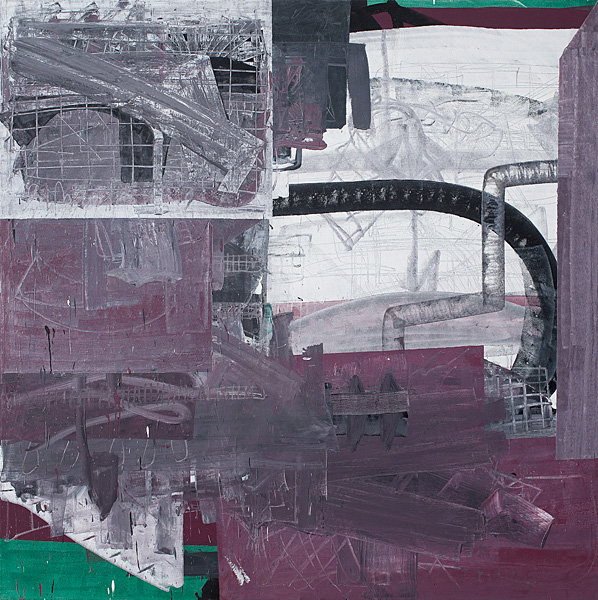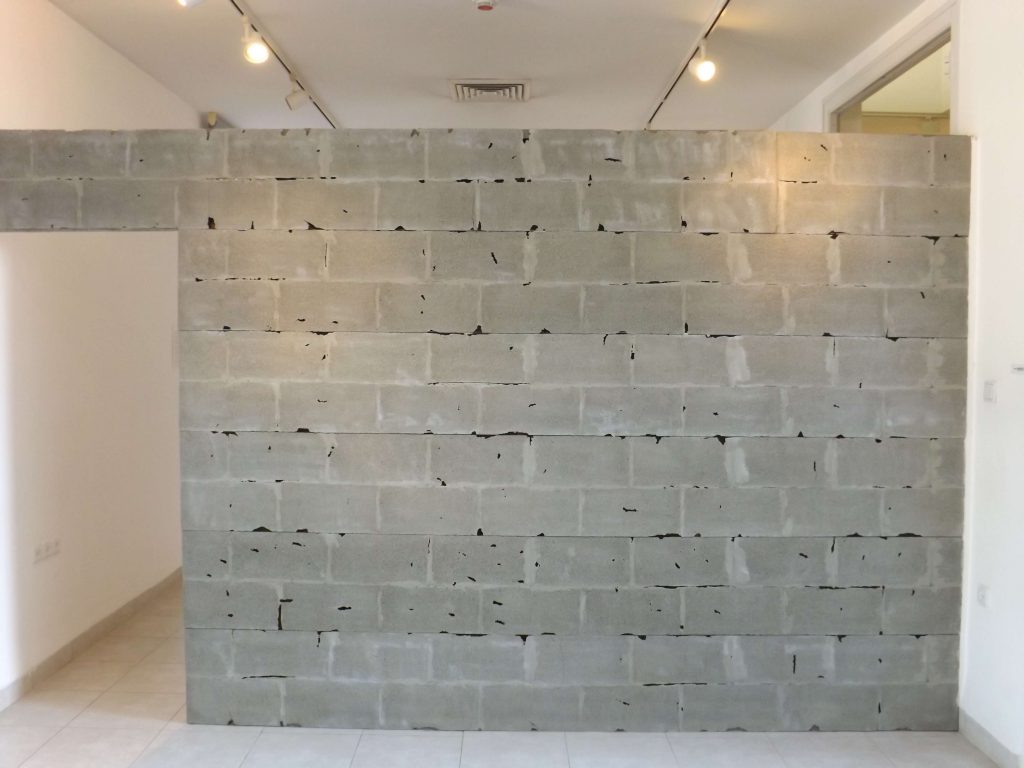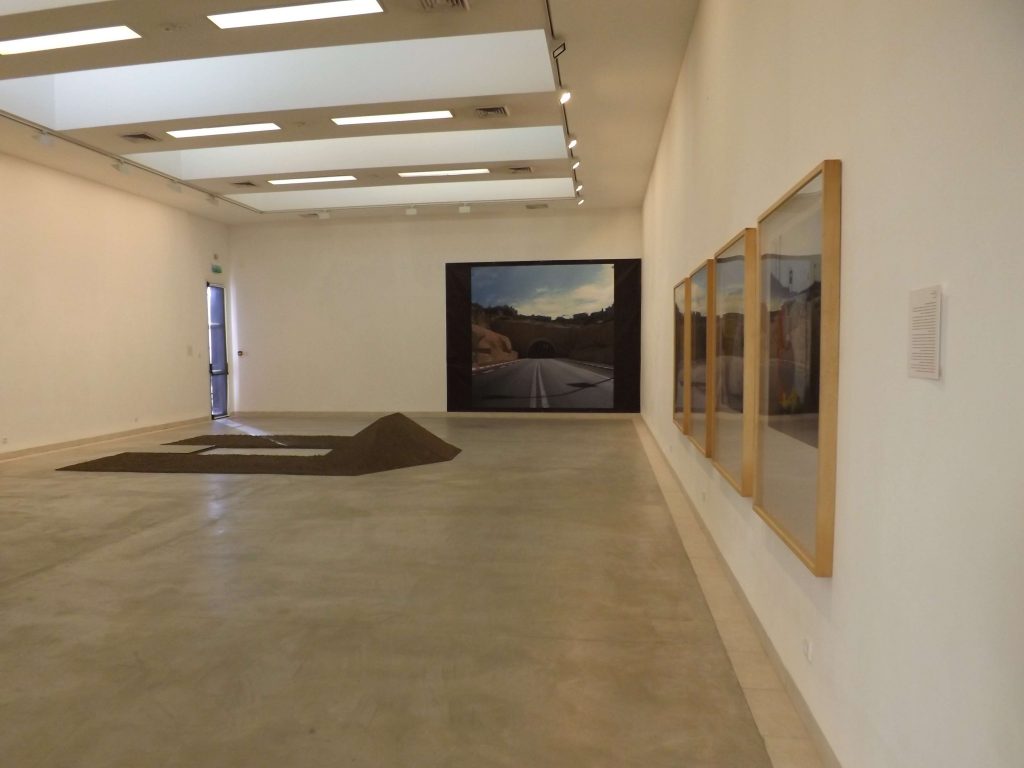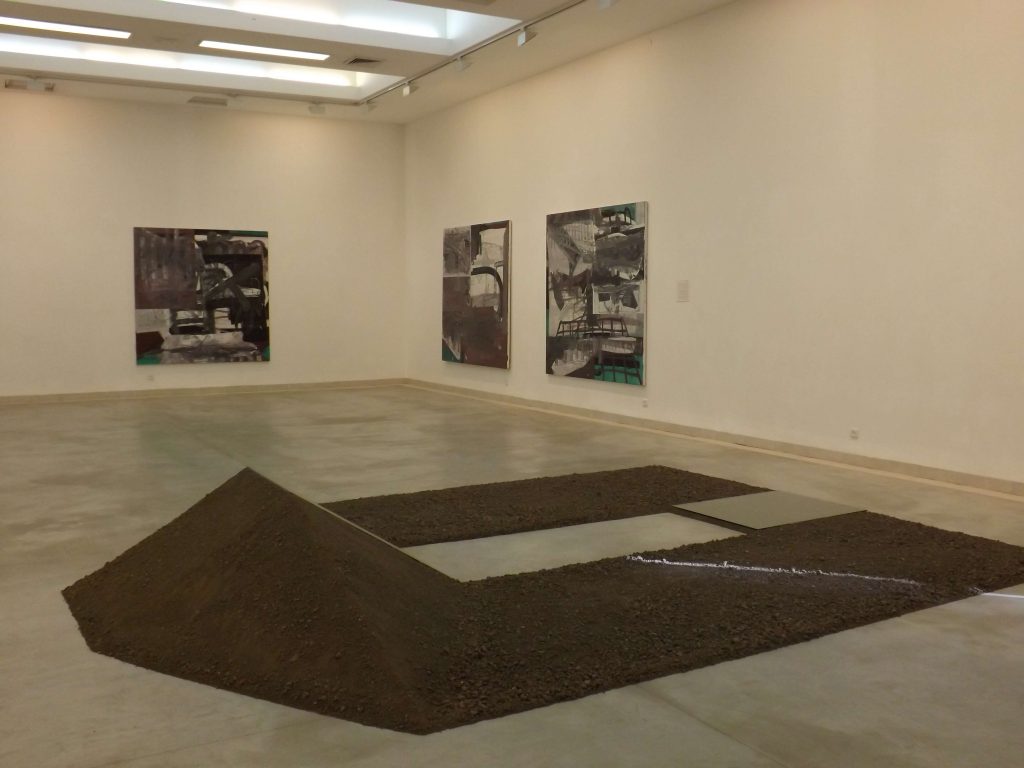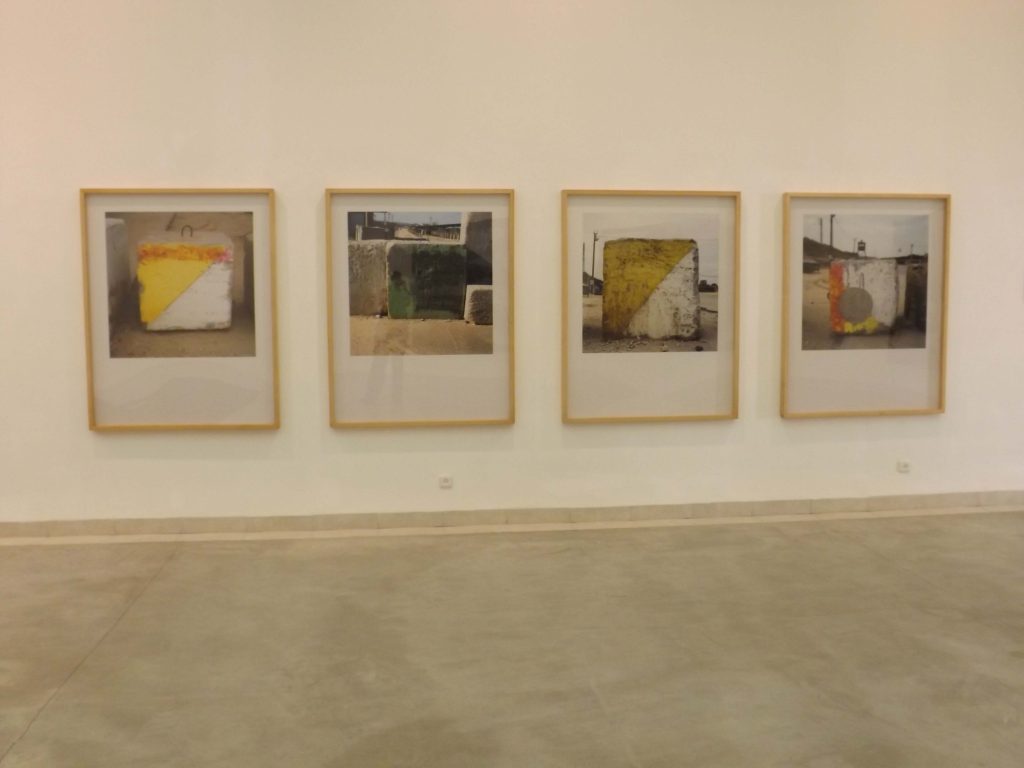Obstructions and Openings
November 2014, the Kupferman Collection, Lochamei Hageta’ot Kibbutz.
Moshe Kupferman, Micha Ullman, Guy Raz, Haimi Fenichel
Curator: Noa Raz-Melamed
“A gatekeeper stands before the law. A villager comes to this gatekeeper and asks him for permission to enter the law. But the gatekeeper says that he can’t allow him to enter now.
The man thinks a moment and asks if he may be permitted to enter later. “Perhaps,” says the gatekeeper, “but not now.” Since the door to the law is always open, when the gatekeeper moves to the side, the man twists to look in through the gate. The gatekeeper sees this and laughs, saying: “If it attracts you so much, why don’t you try going in anyway, despite my prohibition. But consider that I am very strong and I am but the last of the guards. Between one hall and another there are other gatekeepers, each stronger than the other, so much so that even I can barely look at the third guard.”
The villager did not expect such difficulties: He says to himself that the law should have been open to everyone at all times. But now, as he inspects the gatekeeper with his fur coat more closely, his large and pointy nose, his black Tataric beard, so long and thin – he decides that he had better wait until he is given permission to enter.”
From: Before the Law
Franz Kafka “The Verdict and Other Stories (translated by Ilana Hamerman), Am Oved, 1997.
Tension between restraint and abandon, between freedom and its restriction, is one of the more salient elements in Kupferman’s oeuvre. He shifts between moments of fast action in which the hand seems to move of its own volition in wide motions and alternating rhythms, and restrained and repetitive work, sometimes using a ruler and a fixed-width graphite, thus creating a disciplining and restraining barrier.
The observer’s gaze moves between the various levels, vacillating between the desire to “peek” and delve into the depths of the painting, and the symbols that limit, arrest and retard, which call the observer to cling to the more immediate and restraining level. Sometimes this order is inverted.
The exhibition deals with these oscillations – between the basic need to be free to pass, to enter the gate and be there, and the remaining in place, the impediment, the abstention, the delay.
The exhibition discusses the boundaries of power and issues of control.
We stand before. We face it. What is there? Before the place? What was there before? Before what there is there now?
Micha Ullman opens apertures: – a window, a door, an opening in a house. Empty spaces bounded by earth. The observer is reflected in the glass under him or facing him. He is here and he is there. Two works, the window and the door, have been especially created for this exhibition.
These are heaps of local soil, demarcating and framing spaces. Domesticated and processed heaps. The potential for slippage and the blurring of boundaries is present and influential. It forces the observer to breathe differently – gently. The earth aspires to return to it shapeless form. The artist imposes boundaries – disciplines it. The hand has left its imprint on the sides of the heap – compressing, pressing, patting.
Ullman’s excavations in the soil began in the seventies, as a political act of protest that raised questions about the ownership of the land and the triangle man-soil-blood. A man digs a hole in order to plant a tree, to dig a grave. Ullman not only descends to the depths of the earth in his excavations but also expands and augments the celestial realm in the world. The empty pit is full of sky. The gaze of the observer is filled with empty space.
Pulling down, the window frame reflects the windows of the Kupferman collection exhibition hall ceiling, which let in the natural light. Descending to the bottom, the gaze then rises to the heavens – light from the sky.
The “human” is the criterion of Ullman’s work. The human body dictates the proportions. The size of the window and the door in the work are derived from their real size in homes. The space of the heap that supports the glass door marks the boundary of its opening and closing possibilities. What is and what is not.
Ullman’s figurative language strives for simplicity, clarity and minimalism. He touches the sacred and the profane, life and death, the universal and the local, the natural and the cultural, yet he deals with these wide and existential issues with great modesty and calm.
Ullman’s works are usually characterized by a brown-reddish color. The color of the land in the Sharon, his home area. It is the color of iron rust. The rusted iron and the red loam come together in his creations to the point that it becomes difficult to determine where one material ends and the other begins. It is a closed circuit between the solid and the crumbled, the cultural and the natural.
The works in the present exhibition are almost black. Heavy shadows lie across the floor like a memory. The window is made of the dark hard soil of Lochamei Hagetaot. Its clods crumble to dust, to grains, to sand. It echoes Ullman’s well-known creation “library” placed at the Bebelplatz in Berlin – a silent scream against the 1933 burning of the books.
The photographs of Guy Raz document obstructions and tunnels.
The first of the familiar IDF checkpoint barriers appeared within the boundaries of the Green Line in January 1991, after the Palestinians danced on the roofs during the Gulf War, as Scud rockets fell within Israeli territory.
Raz identified the distinct mark of the occupation – the checkpoint stones.
Over the period 1992-2000 Raz documented most of the IDF’s checkpoints around Gaza, Judea and Samaria in color photographs. He continues to travel all over Israel since then – collecting the signs and marks of oppression and occupation, direction and policing, transitions, shortcuts and black holes in the landscape. These stones are “made up” concrete cubes, as if in a modernist painting. Portraits of obstruction, of domination, of command (Guy calls them a “political abstract”). A stone that is not a stone, that is not organic, but stamped in a square die – the mark of civilization.
Raz then proceeds with a journey back in time, in search of historical checkpoints throughout Palestine-Eretz Israel, i.e., the checkpoints that were set up in this area during the period 1941-1967. He ultimately photographed 19 such checkpoints: French, English and Jordanian. These are black and white photographs mainly taken during the period 1995-2000, and finally in 2007, the year of the disengagement from Gaza, at a storage site adjacent to the Kissufim checkpoint, Raz photographed such heaps of stones that seem at first sight like colorful Lego bricks, always ready for assembly and dismantlement according to the army’s needs.
The photographs documenting the tunnels road were taken when the road was opened in 1998 and first displayed at the beginning of 2000 – which subsequently became the first year of the Second Intifada. The Israeli road that connects Jerusalem and Gush Etzion by means of bridges and tunnels led Raz to point to the possibility of the co-existence of two parallel entities within the spaces of this land – both above and below ground.
Thus, Raz’s work in fact presents us with layered fragments of obstruction: squares and rectangles, a barrier, a window, a door. The photographic frame is bounded. Right angles identity the four corners of the earth; positive and negative; hollow and full; ignorance and subterfuge; window and barrier; gate and wall.
Moshe Kupferman, a Holocaust survivor, came to Israel as a refugee For this reason boundaries and routines are a source of security and sanity for him. The shape of the fence, the bars, also echo the straight and parallel lines of the wooden beams used by Kupferman during the period that he worked in construction on first coming to Israel. The straight lines express a routine of blessed work with a steady and stable rhythm. Moral value is attached to frugality and contentment with one’s lot in life.
Kupferman’s creation deals with concealing and revealing, with erasing and exposing, with pointing to the knowledge that there is always something more behind what is revealed to the eye, and something that was there before.
The exhibition presents three works from Kupferman’s series “The Break and the Time” or “The Ripping” – one of the peaks of Kupferman’s oeuvre.
The paintings, commissioned by Yad Layeled of Beit Lochamei Hagetaot, were created in 1999. This is the first of Kupferman’s series where one can point to a clear and direct connection to the Holocaust. The series includes eight paintings in square format (which is quite atypical of Kupferman) and was first exhibited in 2000 at the Givon Gallery.
Kupferman has accompanied this series with a verbal narrative that connects each of the eight paintings to a different stage in the experience of occupation, deportation, life as a refugee, wanderings and the attempt to return to normalcy.
Kupferman’s unique pictorial approach – the layered painting – is particularly salient in these paintings. A painting created from an endless number of activities placed one beside the other, one on top of another and one within another – creating collisions, conflicts and contradictions. These paintings allow us to see something of the process through which the painting was created. The presence of an underlying green layer comes through in each of these works.
The conflicts and struggles through which the artist went are visible rather than hidden. Indeed, they are the very subject of the painting. Kupferman instills a moral value in such actions as erasing, scraping layers and exposing the layers beneath. He juxtaposes different states of area coverage and creates nuances of the same color. This is an existential condition. No attempt is made to unify the picture and bring it to a complete and harmonious state. The split, the multiplicity and the impossibility of creating unity – are the very essence of the work. The observer is thrown into the time of creation itself, and perhaps even to an earlier time – the time of that memory.
The usual entrance to the Kupferman collection has been blocked by the work of Haimi Fenichel, ” Wall”.
The observer is blocked by a simple grey wall, lacking any unique attributes. It is a completely mundane object – a wall made up of blocks that is exactly identical to the many walls that we have seen in the course of building a house or a separating wall. Rows of bricks, each of which is placed at the center of the two below it. Construction as a value. The process is exposed to the eye of the observer. No plaster or paint has been applied. It is the naked truth – the truth of the material, so characteristic of modernist sculpture.
Only a focused inspection of the wall from the side reveals the fact that the wall is but an accurate facsimile – an illusion.
It is just a cast echo of a wall. A dress of concrete and cement. A thin and fragile shell, perforated and brittle.
Haimi creates an illusion of a material by means of the same material. He reincarnates forms, creates a metamorphosis.
Thoughts of locality, home, construction and material engage Haimi Fenichel throughout his oeuvre. The statue before us both obstructs and opens. This is a work of art, but it is also a tangible wall in space – separating between outside and inside, between the space outside and the artistic, metaphorical space.
The stability and confidence projected by the grey wall are revealed as a false promise. The assurance that “everything is alright” is revealed to be an empty slogan. There is no one to count on and nothing to rely on.
The barrier limits and arrests – invites circumvention, invites transgression, like Adam and Eve, it calls for an opening of the gate. Open Sesame. Yet, the inability to open creates an intimate delay before the obstruction, an in-depth introspection of the gate itself, the gate keeper, the barrier, the painting, the sculpture, the photograph.
Out of the limitation of colors and shapes, the constant repetition of the sequence of activities, the strict discipline, curtailment and rigid regularity, give rise to endless variations, demarcating boundaries, demarcating freedom.
Noa Raz-Melamed
